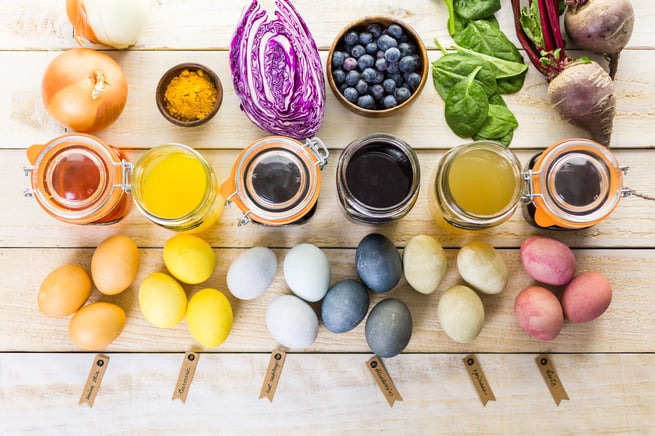Updated 6/11/24
Dyeing and decorating eggs is a must in many households around the Easter holiday. Generally, families use the ready-made dye tablets you can snag in a box on any endcap in the supermarket. It’s a simple process: pour in water and vinegar, drop in the dye tablet, plop in the egg, stir around, tap off the excess, and dry.
Pretty straightforward procedure, right?
Well, during that process, there’s actually some pretty cool science that occurs to make the transformation take place. Typical dyes require acidic conditions to make the eggs change color, which is why the everyday staple of vinegar is used.
Let’s Break Down Why
An eggshell is made from calcium carbonate. Just on the exterior of the shell is a protein cuticle, sometimes called a bloom. This cuticle can’t be seen, but it protects the egg from debris and bacteria.
The eggshell and cuticle react to the acid that is added to the dye. First, the acid breaks down the shell, providing more surface area for the dye to attach to. After you drop your egg into the dye, the little bubbles you see on the liquid’s surface are carbon dioxide gas bubbles, which is an indication that a reaction is occurring. The acid adds positively charged ions, hydrogen protons, to the mix – that’s called protonation. The negatively charged molecules in the protein cuticle and the eggshell are like a magnet for the extra hydrogens that collect on the surface along with the dye.
(Note: The cuticle is sometimes washed off in commercial preparation for distribution, which is one variable that can determine how vibrant your dyed eggs become.)

If you want to skip the dye this year and try using natural coloring, look no further than beets, cabbage, turmeric, blueberries, and onions. We can thank chemistry for these natural options. But don’t be surprised if some natural ingredients don’t result in the colors you expect. Red cabbage, for example, results in blue eggs (or green if you’re using brown eggs)! For tips and instructions, check out Mommypotamus.com or Better Homes & Gardens.
More Egg-tastic STEM/STEAM Activities
Let your students get creative with designs by using rubberbands or a wax crayon to repel the dye. You can also skip the die and use paper towels and water soluble markers with vinegar for a fun effect. Or paint them with watercolor or use markers to draw on the dyed eggs for a layered design.
If you want to do a whole series with egg experiments, pre-empt dyeing eggs with the egg in a bottle, floating eggs, egg-drop vehicles, and the rubber egg activities.
Bonus: Want to know how to get perfectly boiled eggs so they’ll survive the hunt? Science, again, is here to save the day! Check out The Science of Cooking a Pefect Hard-Boiled Egg.
MORE RESOURCES:




